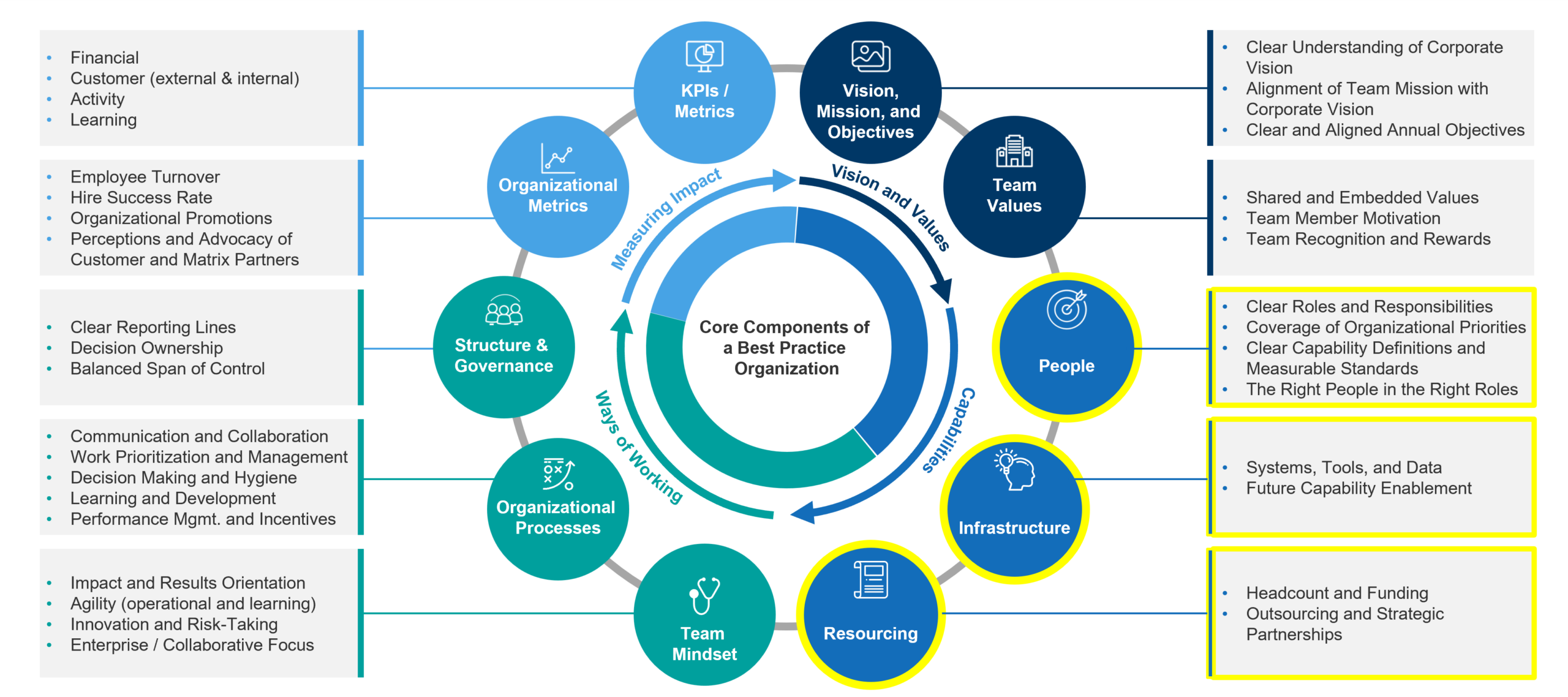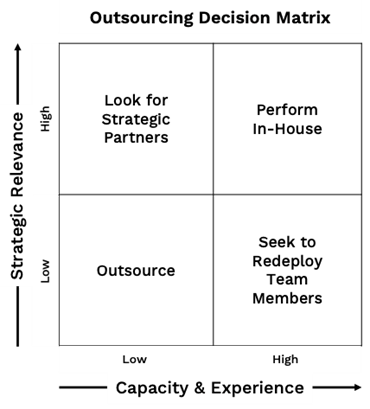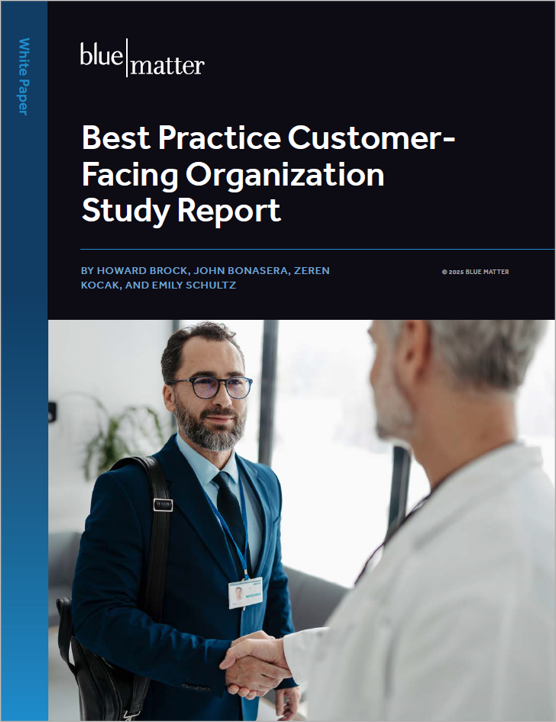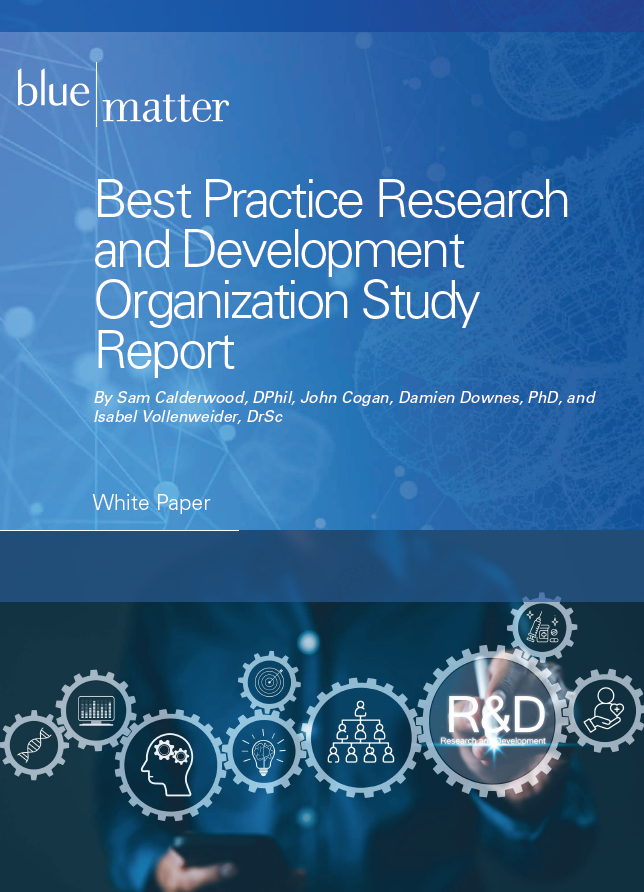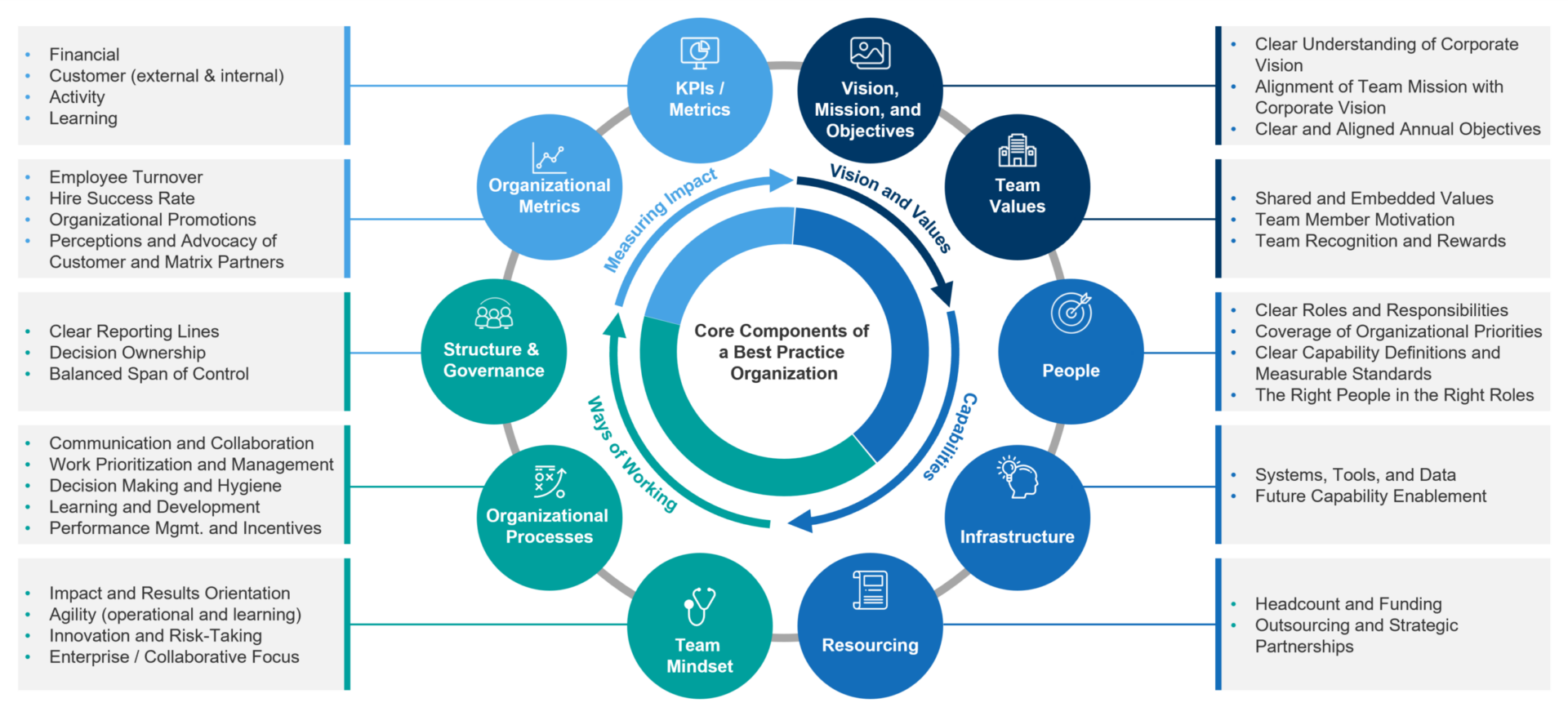
The capabilities that a biopharmaceutical company possesses are an essential element in being a “Best Practice Organization” (BPO). Operating as a BPO is vitally important for companies in the technically complex, fast-paced, and highly regulated biopharma industry. There are four categories that companies looking to be a BPO must pay attention to:
- Vision, Mission, and Values
- Capabilities
- Ways of Working
- Measuring Impact
We looked at what it takes to be a BPO in part 1 of this series. In part 2, we took a deep dive into how defining and operating with clearly articulated vision, mission, and values can help biopharma companies thrive.
In this article, we look at what capabilities are and why they’re a key success factor for being a BPO. We then take a detailed look at three important components of capabilities: people, infrastructure, and resourcing.
Understanding Capabilities and Why They Matter
Capabilities are dynamic, changing to match the needs of different situations. The combination of people, infrastructure, and the resourcing associated with both work together to define what an organization is able to do.
The importance of having strong capabilities in a rapidly evolving space like the biopharma industry is clear. A strong set of capabilities allows individuals and teams to respond appropriately to new circumstances and information, and they support people in gathering data, making decisions, and solving problems. Simply put, the better a biopharma organization’s capabilities, the better it is prepared to perform optimally in today’s complex environment.
People
An organization’s people are a critical component in enabling it to be a BPO. There are several elements to this:
- Clear roles and responsibilities (What people need to do)
- Coverage of organizational priorities (Who does what to collectively cover priorities)
- Clear people capability definitions and measurable standards (The behaviors,characteristics, and expectations that enable people to work effectively)
- The right people in the right roles (The match between someone’s role and their capabilities)
These four sub-components are intertwined, and must be considered together. We will look at each in order.
Roles and Responsibilities
One of the most important parts of developing roles and responsibilities is role definition. The first step in this process is to define the categories of work (e.g., global brand strategy, global go-to-market planning, organized customer engagement, customer experience planning, international markets field effectiveness) that are required to achieve organizational priorities. The next step is to coalesce these categories of work into distinct roles. Providing clarity in defining roles can help individuals understand their own areas of focus and that of their peers to increase alignment and coordination and reduce redundancy of effort.
Establishing clear responsibilities grows out of effective role definition. Responsibilities are derived by determining the discrete activities that fall within the specific categories of work that define the role. For instance, if one of a role’s categories of work is global go-to-market planning, then responsibilities could include chairing a cross-functional team, determining go-to-market strategy and timing, and defining a go-to-market calendar. As with roles, responsibilities should connect to each other in a logical manner and be transparent and aligned across roles to improve coordination. A best practice organization frequently examines the roles and responsibilities of its team members, making adjustments as required to ensure everything the team does supports the mission.
Coverage of Organizational Priorities
Ensuring that organizational priorities are covered is another key to supporting development of the capabilities a company needs. To do so, leaders must do more than simply define roles from the bottom up. They must also think top-down, considering all of the responsibilities in the organization and how they are to be covered. To help individuals understand their roles, many organizations use a RACI matrix, identifying who is Responsible, Accountable, Consulted, and Informed about each given task.
| Capabilities Case Study—Roles, Responsibilities, and Coverage of Priorities A US-based emerging biotech company was preparing to launch its first product in Europe and needed to define who was going to do what (both at the US headquarters and within its to-be-built European organization). The company first defined all the work that would be required, categorizing by function and geography. The company then determined the roles required to get the work done. This included new roles as well as redefining some existing HQ-based roles. Once complete, the company identified the major responsibilities of each role and used a RACI table to capture the inter-relationship and ensure proper organizational coverage. This was critical to minimize friction between US HQ and European team members while ensuring all key tasks were completed. This enabled team members to have a clear understanding of what everyone was responsible for as the team moved at speed to prepare for what became a successful market entry. |
People Capability Definitions and Standards
People capabilities are transferable behaviors and characteristics applied flexibly across a broad range of different conditions, situations, and contexts. While roles and responsibilities define what people do, people capabilities define how they do it. For instance, for a customer-facing role that is a single point-of-contact in a complex rare disease market, capabilities such as effective listening, systems thinking, and customer centricity define how individuals in this role should do their work.
Companies looking to be a BPO must define these capabilities clearly. They also need to establish measurable standards for them, so that individuals can compare themselves to the standard and determine their development pathways. These standards can fall into categories such as “Developing,” “Proficient,” and “Mastery,”. As People capabilities are often transferable across roles, these standards help define career pathways (as different standards may be expected for different roles). For instance, an Associate Brand Manager may only need to be “Developing” in a capability such as Strategic Thinking, while a Brand Director would be required to demonstrate “Mastery.”
These capabilities should be captured in a capability model. A capability model is a description of the knowledge, skills, and observable behaviors that a particular role demands, now and in the future. The benefits of capability models accrue both at the leadership level and at the individual level. For leaders, they can help make sure that team and individual development is aligned with organizational goals. For individuals, they enable team members to build personalized development plans to help them reach their professional goals.
Finally, clear people capabilities and standards should be used to guide both training curricula as well as the performance management process. A training curriculum is a defined plan specifying the learning goals, content, and action steps required to achieve proficiency and/or mastery of a capability or set of capabilities to enable better role performance. When organizations build strong training curricula, they are setting their people up for ongoing success in their roles.
The Right People in the Right Roles
Having the right people in the right roles is another key feature of a best practice organization. To do this, organizations must understand the necessary responsibilities and capabilities for the roles they are filling, and then determine the criteria by which they will assess role incumbents or candidates.
Companies can best gauge someone’s fit with responsibilities using prior experiences and qualifications, and their level of capability using case study and behavioral interview questions relative to an agreed-upon rubric of standards.
For incumbents, it is important for leaders to assess their team relative to the required capabilities of the role as part of the performance review cycle. If a team member has a gap, leaders must determine whether to invest in developing the team member or to look elsewhere.
As a best practice, both the hiring and performance management process should leverage as many objective data points as possible to help the company make evidence-based, unbiased decisions.
Infrastructure
In addition to people, the other primary category of capabilities we will address is infrastructure. We define infrastructure as the systems, tools, and data that enable companies to operate more efficiently and effectively to drive positive business results. As infrastructure typically requires significant investment and planning, it is critical that companies think about future capability enablement.
Systems, Tools, and Data
The better an organization’s system, tool, and data capabilities, the more effective that organization is in its operations. One important element of these capabilities is a cohesive system architecture. That architecture typically includes multiple systems, including customer relationship management (CRM) and enterprise planning systems. CRMs are tools for storing and accessing information about interactions with prospects and customers, often in support of sales efforts. Enterprise planning systems typically include a range of capabilities, including people management tools.
Customer data is another important element of this sub-component. It’s a broad category that typically includes volume and claims data, product access data, clinical trial data, and other less structured information such as demographics, personas, and market research.
Data is integrated into system architecture through a combination of a data lake, data access tools (or “sandbox”) for data scientists, and data reporting tools for employees without advanced coding or data analysis skills. For data to be used effectively as a true capability rather than simply as a tool, organizations must guide employees in how, when, and why to use it across a range of different scenarios. Data integration has become increasingly critical as biopharma company portfolios shift to specialty, oncology, rare disease, and cell and gene therapy-based products. Substantial advancements in artificial intelligence capabilities have also increased the importance of customer data, but these capabilities are often not optimized without a strong system, tool and data infrastructure.
Future Capability Development
As biopharma companies seeking to be BPOs think about developing future capabilities, it is important to get past the “buzzwords” of the moment and instead match their activities to the business’s specific needs. In practice, this means avoiding chasing hot trends such as AI, digital transformation, and organizational agility simply because they’re some of the most talked-about concepts at the moment.
These trends may indeed be relevant and valuable for the organization, but the only way to identify that would be to rigorously identify the business’s needs. These could include other, sometimes less flashy dynamics that can support the company’s growth toward its strategic goals: having relevant data and systems in place, putting the right people in the right roles, and establishing well-defined processes.
| Capabilities Case Study—Infrastructure An emerging biotech company was preparing to launch an oncology product and needed to build a commercial infrastructure to support that launch. The company built an account-based infrastructure to support the product’s launch, which enabled the company to identify and track the patient journey through different types of institutional and community accounts. This organizational capability enabled a structure that linked team members with different capabilities, team coordination processes, and valuable data-driven insights. It was a key success factor in the product launch, significantly exceeding the company’s launch forecast. |
Resourcing
An organization’s ability to allocate resources effectively across various priorities is a complex yet crucial element in being a best practice organization. Companies must ensure that teams have the appropriate headcount, people, and funding to achieve the organization’s mission. Doing this includes elements like prioritizing workload, determining service levels, and analyzing customer value impact.
Resourcing has become increasingly complicated for biopharma companies with the growth of specialty oncology, rare disease, and cell and gene therapy products. For example, in the past, companies could simply associate marketing, operations, and training resources to field headcount, but extremely complicated specialty products require a significantly higher ratio of non-field-based resources.
Organizations must develop plans to maintain appropriate resourcing at a time when portfolios and external trends require organizations to be increasingly nimble. Organizations also face challenges such as limited funding, changing organizational priorities, and downsizing. In those cases, companies must have both the flexibility and contingencies in place to enable them to optimize resources through other channels, whether internal or through partnerships and outsourcing.
To determine an organization’s partnership and outsourcing strategy, many use a two-by-two decision matrix, often with Strategic Relevance on the Y axis and Capacity & Experience on the X axis. This can look as follows:
In this matrix, tasks with lower strategic relevance and organizational capacity and experience are good candidates for outsourcing, while tasks with high strategic relevance and high capacity and experience may be best performed with in-house staff.
Next Up
Building off our exploration of how Capabilities and Vision, Mission, and Values can help a biopharma company become a Best Practice Organization, we will next dive in to Ways of Working. This dynamic—how BPOs encourage individuals and teams to balance clearly defined operational structures with sufficient collaboration, risk-taking, and innovation—is key to biopharma companies’ success in the market.
